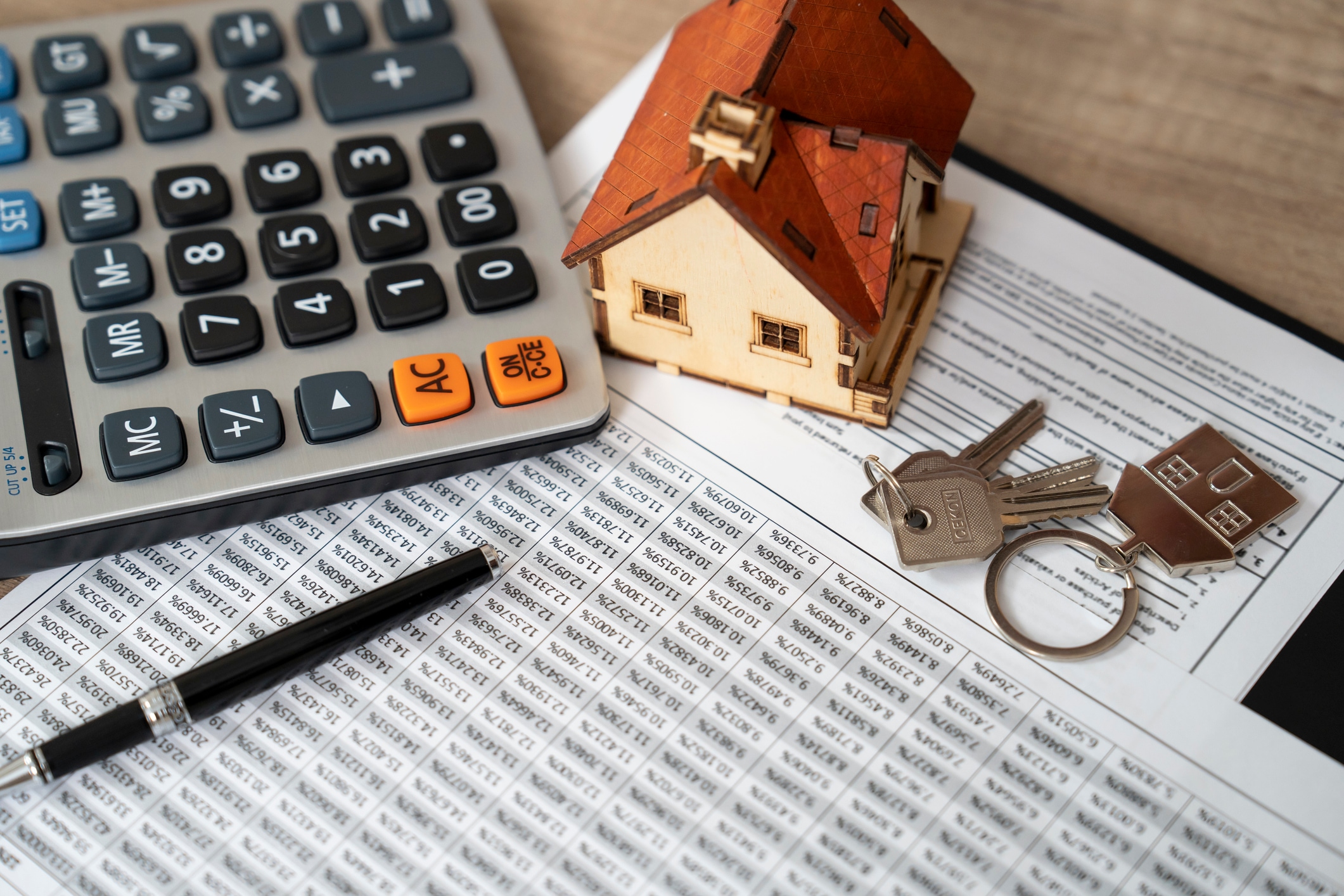The simple way to determine how much house you can afford is to calculate your monthly household income and compare that to the expenses likely for the type of home you want to buy, including your monthly mortgage costs. After that, the basic rule of thumb is that you should allocate no more than 28% of your monthly income to housing costs.
But there are a variety of factors that can make this calculation more complicated. To be as accurate as possible, you need to factor in your debts, credit score, down payment and assets, as well as other ongoing expenses tied to homeownership, like homeowners insurance.
We’ll walk you through the process to help you establish a homebuying budget in the following eight steps.

Step 1: Estimate Your Income and Debt with the 28/36 Rule
A common guideline to estimate how much you can afford to spend on a house is the 28/36 rule. This recommendation suggests that no more than 28% of your gross monthly income (the total amount that you earn in a month before taxes and other deductions) should go toward your total housing costs, and that no more than 36% should be spent on your total debts.
The 28/36 rule is a measure of your debt-to-income (DTI) ratio. Your total debts could include student loans, car loans, credit card payments or child support. When a mortgage lender evaluates your DTI ratio, they also factor in your estimated housing payments, including mortgage, property taxes, homeowners insurance and homeowners association dues.
The formula to calculate your DTI ratio looks like this:
DTI Ratio = Total Monthly Debts ÷ Gross Monthly Income
In general, a DTI ratio of less than 36% will help you qualify for the best mortgage rates. However, the average for American homebuyers is around 38%, according to ICE Mortgage Technology.
Many lenders also offer higher limits that are typically around 45%. “Banks will require that you spend no more than 43% to 50% of your monthly gross income on the new home, as well as any other monthly obligations,” says Melissa Cohn, Regional Vice President of William Raveis Mortgage.
DTI Example: Your Monthly Payments on a $72,000 Salary
Let’s assume you earn an annual salary of $72,000, slightly more than the national average of $65,470 that the U.S. Bureau of Labor Statistics most recently reported. In this scenario, your gross monthly income is $6,000 per month.
The 28/36 rule indicates that you can budget $1,680 per month for housing costs and your total debt payments should be no more than $2,160. If your lender allows a DTI ratio of 45%, your total monthly debts – including your housing costs – should not exceed $2,700.
Step 2: Assess Your Down Payment and Reserve Requirements
Lenders want to see strong financial standing when you put money down toward a home. Typically, you will get the best mortgage rate if you can make a 20% down payment, but that’s not necessarily the norm. A down payment of 15% is the U.S. average, according to the National Association of Realtors (NAR).
You can qualify for a mortgage with less money down, too, but lenders also consider your assets as part of the approval process. “You will also have to meet any reserve requirements,” Cohn says. The reserve requirement for many lenders is to have two to four months of mortgage payments in your remaining assets. “These reserves can be in retirement funds,” Cohn adds.
Step 3: Consider How Your Finances Will Impact Your Interest Rate
The interest rate that you’ll qualify for depends on your financial profile, the type of loan that you choose and economic conditions. Even small adjustments to a mortgage rate can mean a difference of thousands of dollars in your total loan cost.
When determining your monthly mortgage payments, your interest rate is an essential factor. The criteria that can impact your interest rate include:
- Your credit score: “The higher the score, the better the rate,” says Cohn. A credit score of 670 or above will typically get the best rates.
- Your debt-to-income (DTI) ratio: A higher DTI ratio comes with higher interest rates.
- Loan terms: The length of time a borrower has to repay a loan is typically 15 or 30 years. Shorter loans carry lower interest rates. Longer loans are more accessible because they have lower monthly payments, but you’ll pay more in interest in the long run.
- Loan type: Conventional, FHA, USDA and VA loans have different mortgage rates.
Step 4: Find a Mortgage that Meets Your Needs
Most homebuyers finance with a conventional loan, but there are other mortgage options that may offer more flexible rates, especially for buyers with a lower credit score or limited funds for a down payment.
- Conventional loans: A conventional mortgage is a home loan that’s issued by a private lender and not insured by the government. It may be more difficult to qualify for with a credit score below 620. Homebuyers tend to put down a 5% to 20% down payment, but some lenders will allow as little as 3%.
- FHA loans: An FHA loan is backed by the Federal Housing Administration and is designed to help buyers who have a lower credit score, a higher DTI ratio, or both. It’s possible to secure an FHA loan with a credit score as low as 500 if you can put 10% down. With a credit score of 580, you can finance with a 3.5% down payment.
- VA loans: VA loans are insured by the Department of Veterans Affairs (VA) and are available to service members, veterans or qualifying surviving spouses. The VA does not require a down payment or a minimum credit score. However, lenders often look for a minimum score of 620.
- USDA loans: USDA loans are backed by the Department of Agriculture and offer a zero-down-payment mortgage for buyers in qualifying rural areas. These loans do not have a minimum credit score, but lenders typically require 620 or higher.
Step 5: Get Preapproved for a Mortgage
A mortgage preapproval is the most accurate way to determine how much you can afford to spend on a home. It’s a formal quote from a mortgage lender that indicates how much money you can borrow and your interest rate. Different lenders will quote different rates, so it’s wise to explore this process with multiple lenders.
During this process, the lender will perform a “hard inquiry” to pull your credit rating, which can affect your credit score for one year. The good news is that you won’t be penalized if you shop for the best interest rate from multiple lenders within 45 days. Most preapprovals are good for 30 to 90 days, so it’s wise to only get preapproved when you are serious about buying.
Step 6: Factor in Your Additional Monthly Expenses
Although mortgage payments will likely make up the bulk of your monthly home expenses, owning a house comes with plenty of additional monthly costs, including:
- Homeowners insurance: Mortgage lenders typically require homeowners insurance. Prices vary depending on location, your credit score and the property’s age.
- Property tax: Property tax rates vary by location but typically cost between 0.5% and 2.5% of the home’s value. All homes for sale on Homes.com include the tax history and an estimation of current property taxes.
- Homeowners Association (HOA) fees: HOA fees are most common in condominiums or master-planned neighborhoods. The fees go toward the management and maintenance of the community, including communal spaces like pools, tennis courts or lobbies.
- Utility costs: According to Move.org, the average U.S. household spends $583 per month on utilities. Your real estate agent or local utility providers can help provide more specific estimates.
- Maintenance: A commonly used guideline is to budget 1% of your home’s value per year for maintenance costs. For older properties, you may want to budget more.
Step 7: Plan for Closing Costs and Start an Emergency Fund
- Closing costs: These are the fees associated with the homebuying process, such as appraisals, attorney fees, and title insurance. They typically range between 3% to 6% of the home’s purchase price.
- Emergency fund: It’s impossible to account for every expenditure or emergency that might come up when you buy a home. So, it’s a good rule of thumb to have enough money saved to cover three to six months of living expenses.
Step 8: Use the Mortgage Calculator on Every Homes.com Listing
At this point, you should have a solid understanding of how much you can spend each month on a home, and fortunately, there’s a quick and easy way to ensure that the listings that have piqued your interest are within your homebuying budget.
Every listing on Homes.com includes a home affordability calculator. You can adjust your down payment, interest rate and loan term to explore different financial scenarios. Plus, the calculator pulls from real estate records to offer a property-specific analysis of taxes, HOA fees and homeowners insurance.
Your Home: One of Best Investments You Can Make
Buying a home requires a strong look at your financial situation, including your income, DTI ratio, assets and credit score. You’ll also need to determine what you are comfortable spending, and how much your lender will let you borrow.
You should account for every line item that impacts your monthly payment, from your loan amount and interest rate to hidden costs such as homeowners insurance, utilities and a back-pocket emergency fund. This will ensure that you know how much house you can afford when it’s time to start looking for your new home.
While a home purchase has significant costs, the payoff can be substantial. In 2023, home sellers made an average profit of $121,000, according to ATTOM Data. That return on investment makes buying a home one of the best financial decisions you’re likely to make.
Virginia native Catherine Lashley loves exploring other areas of the country through her work. “Writing about a neighborhood feels like getting to know a new friend,” she says. “I enjoy spending time with them to find out their story.” Catherine is an experienced and thoughtful content writer with a bachelor’s in English from the College of William & Mary. Her previous experience in search engine optimization forms the backbone of her journalistic storytelling at Homes.com.














